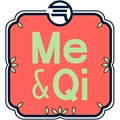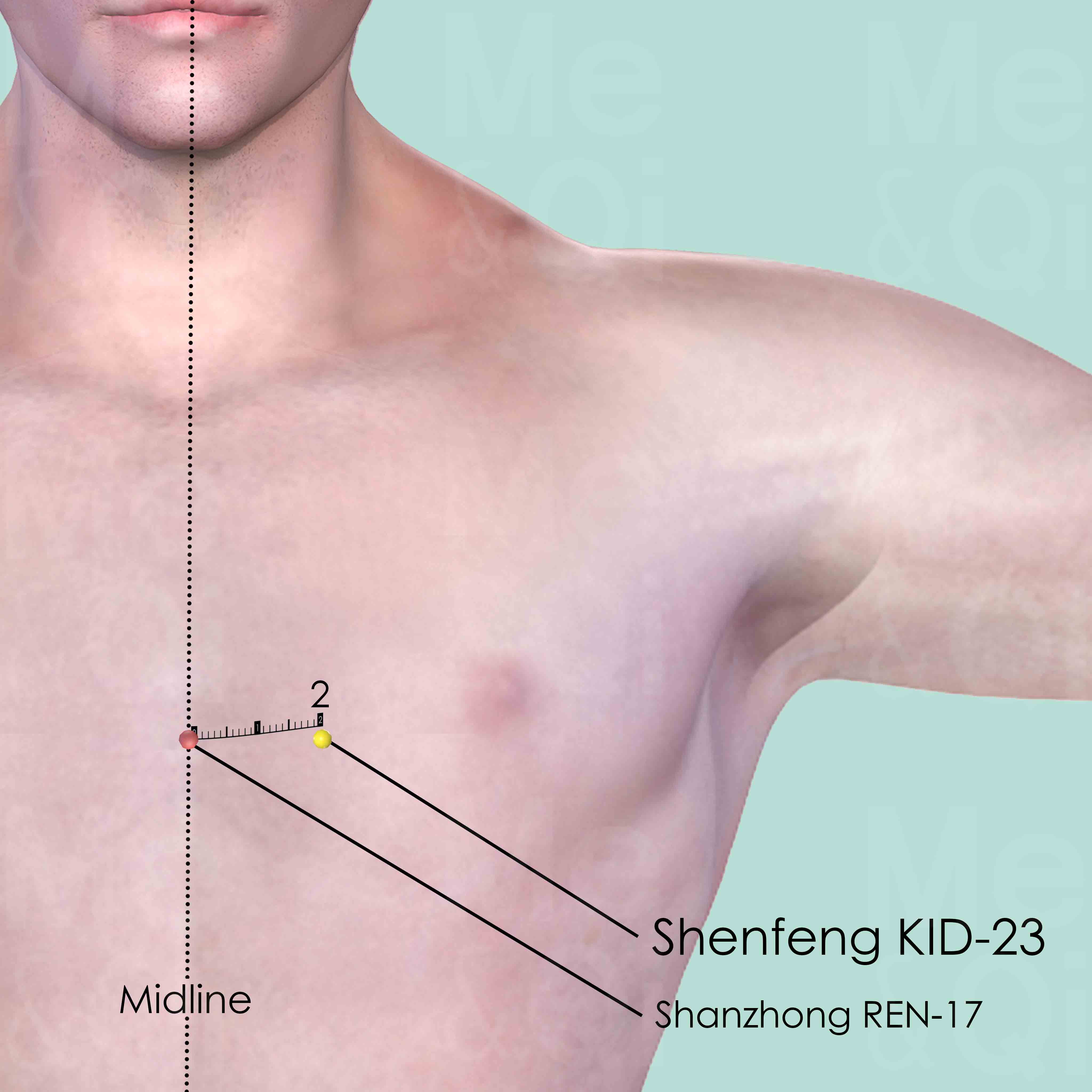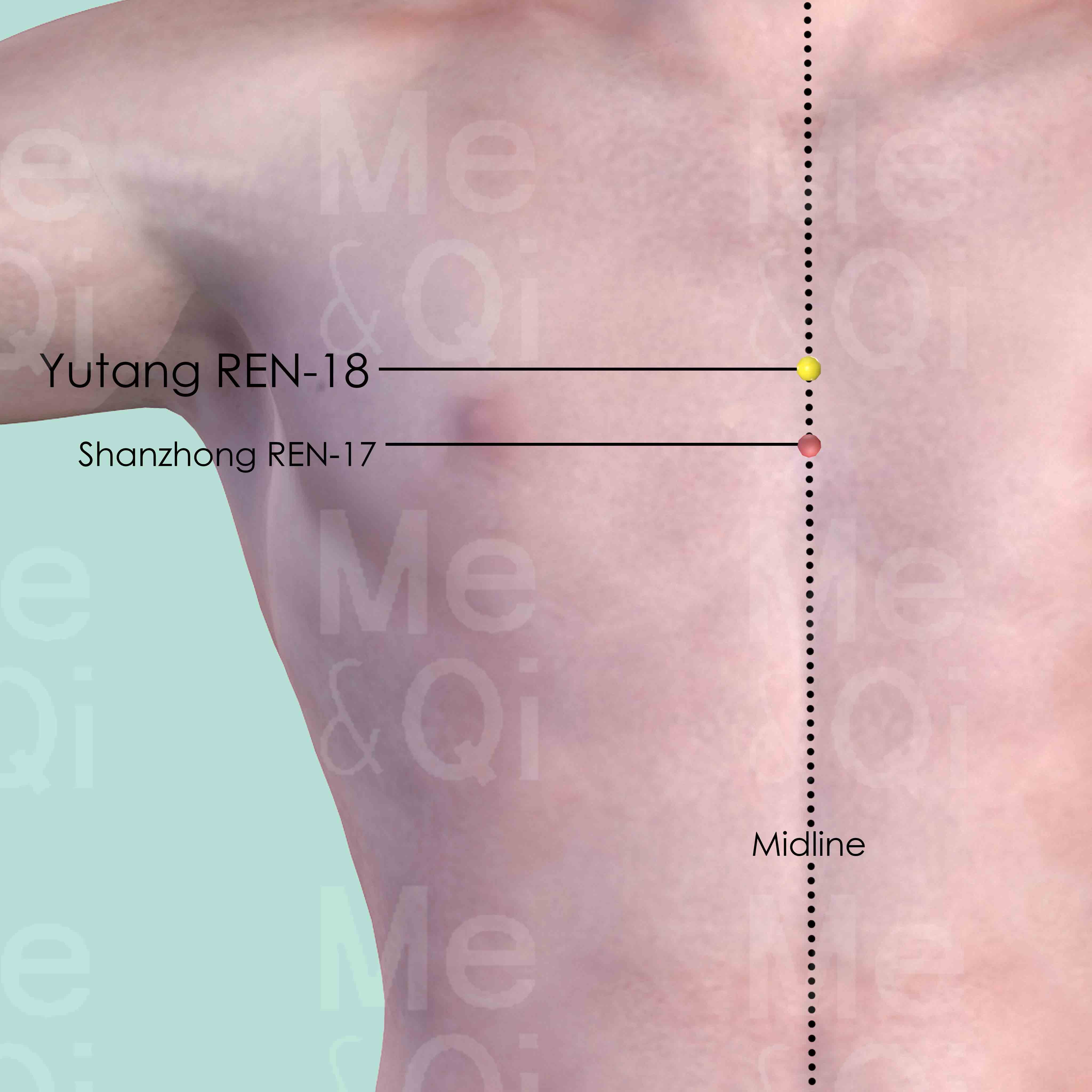Breast Painaccording to TCM
Symptom family: Chest Discomfort & Sensations
Did you mean? Chest Pain
Root Causes of Breast Pain in TCM
Explore below more details about what might cause Breast pain according to TCM.
Qi Stagnation
Qi Stagnation in TCM is like having a traffic jam in your body's energy system. Qi, the vital life force that flows through your body, is supposed to move smoothly to maintain health and balance. But with Qi Stagnation, this flow gets blocked or slowed down, like cars stuck on a highway. This can lead to symptoms like feeling stressed, emotional mood swings, and physical discomfort, often described as a feeling of fullness or tightness, especially in the chest or abdomen. It's as though the body's internal energy circulation is disrupted, causing various issues. TCM sees this as an energy flow problem, different from modern medicine's focus on specific physiological processes.... see more
Qi Stagnation Patterns That Can Lead to Breast Pain
Common Symptoms: Chest Distension Dark Face Irritability Mood Swings Depression Menstrual Cramps Dark Menstrual Blood Irregular Periods
| Pattern Name | Relevant Symptoms | Relevant Formulas |
|---|---|---|
| Qi And Blood Stagnation | Breast pain, Chest distension, Chest pain, Stabbing fixed pain, Dark face, Purple lips, Purple nails, Irritability, Mood swings, Depression, Mottled skin, Foot edema, Abdominal masses, Melena black tarry stool, Menstrual cramps, Amenorrhea, Dark menstrual clots, Dark menstrual blood, Prolonged lochia, Irregular periods... see more | Ge Xia Zhu Yu Tang | Tao Hong Si Wu Tang | Shao Fu Zhu Yu Tang | Wu Yao Tang | Jia Wei Xiao Yao San | Wei Jing Tang |
| Liver Qi Stagnation | Breast pain, Hypochondriac distention, Chest distension, Upper abdominal distension, Abdominal distention, Sighing, Melancholia, Depression, Mood swings, Irregular periods, Globus sensation, Pre menstrual breast distension, Pre menstrual tension, Anxiety, Anger... see more | Gua Lou San | Xia Ru Yong Quan San | Xiao Yao San | Yue Ju Wan |
Blood Stasis
Blood Stasis in TCM is a concept where the blood flow in the body is not as smooth or efficient as it should be. Imagine a river that's supposed to flow freely, but instead, it's getting blocked or moving too slowly in some parts. This can lead to various health issues, like pain that feels sharp or stabbing, dark bruises, and a complexion that looks purplish. TCM believes that good health relies on the smooth and vibrant flow of Qi and blood throughout the body, so when blood gets stuck, it's like a traffic jam in your body, leading to discomfort or health problems.... see more
Blood Stasis Patterns That Can Lead to Breast Pain
Common Symptoms: Irritability Abdominal Masses Menstrual Cramps Amenorrhea Dark Menstrual Clots Dark Menstrual Blood Prolonged Lochia Irregular Periods
| Pattern Name | Relevant Symptoms | Relevant Formulas |
|---|---|---|
| Qi And Blood Stagnation | Breast pain, Chest distension, Chest pain, Stabbing fixed pain, Dark face, Purple lips, Purple nails, Irritability, Mood swings, Depression, Mottled skin, Foot edema, Abdominal masses, Melena black tarry stool, Menstrual cramps, Amenorrhea, Dark menstrual clots, Dark menstrual blood, Prolonged lochia, Irregular periods... see more | Ge Xia Zhu Yu Tang | Tao Hong Si Wu Tang | Shao Fu Zhu Yu Tang | Wu Yao Tang | Jia Wei Xiao Yao San | Wei Jing Tang |
| Blood Stagnation in the Directing and Penetrating Vessels | Breast pain, Irregular periods, Brown vaginal discharge, Dark menstrual clots, Menstrual cramps, Dark menstrual blood, Prolonged lochia, Lower abdominal pain, Umbilical pain, Breast engorgement, Anxiety... see more | Gui Zhi Fu Ling Wan |
Heat
In TCM "Heat" signifies an excess of Yang energy, leading to an imbalance where heat predominates over the body's cool Yin aspects. This condition is metaphorically akin to an internal over-heating. Symptoms indicative of Heat can include feelings of warmth, fever, sweating, irritability, red face, thirst with a preference for cold drinks, and a rapid pulse. The tongue may appear red with a yellow coating. Unlike the common interpretation of heat in terms of temperature, in TCM, it represents a state of hyperactivity or inflammation in the body.... see more
Heat Patterns That Can Lead to Breast Pain
| Pattern Name | Relevant Symptoms | Relevant Formulas |
|---|---|---|
| Stomach Fire or Stomach Heat | Breast pain, Toothache, Headaches, Stomatitis, Periodontitis, Glossitis, Trigeminal neuralgia, Diabetes, Viral myocarditis, Breast engorgement, Breast lumps... see more | Gua Lou San |
Liver
In TCM the Liver is viewed as the organ responsible for the smooth flow of Qi, Blood, and emotions throughout the body. It plays a key role in regulating mood, storing blood, supporting digestion, and ensuring the health of tendons and eyes. When the Liver malfunctions or is imbalanced in TCM, it can lead to a range of issues such as irritability, mood swings, menstrual irregularities, eye problems, and muscular stiffness or pain. A malfunctioning Liver in TCM reflects not only physical disturbances but also emotional and mental disharmony, emphasizing the holistic approach of TCM in addressing health and wellness.... see more
Liver Patterns That Can Lead to Breast Pain
| Pattern Name | Relevant Symptoms | Relevant Formulas |
|---|---|---|
| Liver Qi Stagnation | Breast pain, Hypochondriac distention, Chest distension, Upper abdominal distension, Abdominal distention, Sighing, Melancholia, Depression, Mood swings, Irregular periods, Globus sensation, Pre menstrual breast distension, Pre menstrual tension, Anxiety, Anger... see more | Gua Lou San | Xia Ru Yong Quan San | Xiao Yao San | Yue Ju Wan |
Stomach
In TCM the Stomach is regarded as the "sea of nourishment," pivotal for digesting food and transforming it into Qi and blood. It works closely with the Spleen to distribute these essential nutrients throughout the body. When the Stomach is out of balance or malfunctions in TCM, it often leads to digestive problems such as bloating, nausea, vomiting, poor appetite, or a feeling of fullness. There may also be issues like acid reflux or a sour taste in the mouth. Emotionally, an imbalanced Stomach can contribute to excessive worry and overthinking, reflecting the TCM belief that physical and emotional well-being are deeply interconnected.... see more
Stomach Patterns That Can Lead to Breast Pain
| Pattern Name | Relevant Symptoms | Relevant Formulas |
|---|---|---|
| Stomach Fire or Stomach Heat | Breast pain, Toothache, Headaches, Stomatitis, Periodontitis, Glossitis, Trigeminal neuralgia, Diabetes, Viral myocarditis, Breast engorgement, Breast lumps... see more | Gua Lou San |
TCM Herbal Formulas for Breast Pain
Explore below some TCM herbal formulas used to address breast pain, organized by cause and by formula type.
- By Cause
- By Formula Type
- Qi Stagnation
- Blood Stasis
- Heat
- View More Causes
- Formulas that invigorate blood and dispel blood stagnation
- Formulas that promote qi movement
- Formulas that harmonize liver-Spleen
- Formulas that clear internal abscesses and sores
- Formulas that tonify blood
- Formulas that clear heat and resolve toxicity
Top Formula for Qi Stagnation:
Gua Lou San
Suitable for Qi Stagnation patterns that may cause breast pain, such as Liver Qi Stagnation
Learn moreAll Formulas Recommended for Breast Pain Caused by Qi Stagnation
| Formula | Patterns Suitable For |
|---|---|
| Gua Lou San | Liver Qi Stagnation |
| Ge Xia Zhu Yu Tang | Qi And Blood Stagnation |
| Tao Hong Si Wu Tang | Qi And Blood Stagnation |
| Shao Fu Zhu Yu Tang | Qi And Blood Stagnation |
| Wu Yao Tang | Qi And Blood Stagnation |
| Jia Wei Xiao Yao San | Qi And Blood Stagnation |
| Wei Jing Tang | Qi And Blood Stagnation |
| Xia Ru Yong Quan San | Liver Qi Stagnation |
| Xiao Yao San | Liver Qi Stagnation |
| Yue Ju Wan | Liver Qi Stagnation |
Top Formula for Blood Stasis:
Ge Xia Zhu Yu Tang
Suitable for Blood Stasis patterns that may cause breast pain, such as Qi And Blood Stagnation
Learn moreAll Formulas Recommended for Breast Pain Caused by Blood Stasis
| Formula | Patterns Suitable For |
|---|---|
| Ge Xia Zhu Yu Tang | Qi And Blood Stagnation |
| Tao Hong Si Wu Tang | Qi And Blood Stagnation |
| Shao Fu Zhu Yu Tang | Qi And Blood Stagnation |
| Wu Yao Tang | Qi And Blood Stagnation |
| Jia Wei Xiao Yao San | Qi And Blood Stagnation |
| Wei Jing Tang | Qi And Blood Stagnation |
| Gui Zhi Fu Ling Wan | Blood Stagnation in the Directing and Penetrating Vessels |
Top Formula for Heat:
Gua Lou San
Suitable for Heat patterns that may cause breast pain, such as Stomach Fire or Stomach Heat
Learn moreFormulas that invigorate Blood and dispel Blood Stagnation
These formulas are suitable for some breast pain-causing patterns like Qi And Blood Stagnation.
One such formula is Ge Xia Zhu Yu Tang, with szechuan lovage root as a key herb.
Other formulas of this category are listed in the table below.
All "formulas that invigorate blood and dispel blood stagnation" recommended for breast pain
| Formula | Patterns Suitable For (if applicable) |
|---|---|
| Ge Xia Zhu Yu Tang | Qi And Blood Stagnation |
| Shao Fu Zhu Yu Tang | Qi And Blood Stagnation |
| Gui Zhi Fu Ling Wan | Blood Stagnation in the Directing and Penetrating Vessels |
| Xia Ru Yong Quan San | Liver Qi Stagnation |
Formulas that clear internal abscesses and sores
These formulas are suitable for some breast pain-causing patterns like Jealous Breast (Du Ru) or Blow Breast (Chui Ru).
One such formula is Tuo Li Xiao Du San, with milkvetch root as a key herb.
Other formulas of this category are listed in the table below.
All "formulas that clear internal abscesses and sores" recommended for breast pain
| Formula | Patterns Suitable For (if applicable) |
|---|---|
| Tuo Li Xiao Du San | Jealous Breast (Du Ru), Blow Breast (Chui Ru) |
| Wei Jing Tang | Qi And Blood Stagnation |
Formulas that promote Qi movement
These formulas are suitable for some breast pain-causing patterns like Qi And Blood Stagnation.
One such formula is Wu Yao Tang, with lindera root as a key herb.
Other formulas of this category are listed in the table below.
All "formulas that promote qi movement" recommended for breast pain
| Formula | Patterns Suitable For (if applicable) |
|---|---|
| Wu Yao Tang | Qi And Blood Stagnation |
| Yue Ju Wan | Liver Qi Stagnation |
Formulas that harmonize Liver-Spleen
These formulas are suitable for some breast pain-causing patterns like Qi And Blood Stagnation.
One such formula is Jia Wei Xiao Yao San, with bupleurum root as a key herb.
Other formulas of this category are listed in the table below.
All "formulas that harmonize liver-Spleen" recommended for breast pain
| Formula | Patterns Suitable For (if applicable) |
|---|---|
| Jia Wei Xiao Yao San | Qi And Blood Stagnation |
| Xiao Yao San | Liver Qi Stagnation |
Formulas that clear Heat and resolve toxicity
These formulas are suitable for some breast pain-causing patterns like Liver Qi Stagnation or Stomach Fire or Stomach Heat.
One such formula is Gua Lou San, with snake gourd as a key herb.
Formulas that tonify Blood
These formulas are suitable for some breast pain-causing patterns like Qi And Blood Stagnation.
One such formula is Tao Hong Si Wu Tang, with peach kernel as a key herb.
Acupoints for Breast Pain
Explore below some acupoints used to address breast pain, organized by meridian.
- By Meridian
- Gall Bladder Channel
- Stomach Channel
- Kidney Channel
- Bladder Channel
- Small Intestine Channel
- Directing Vessel
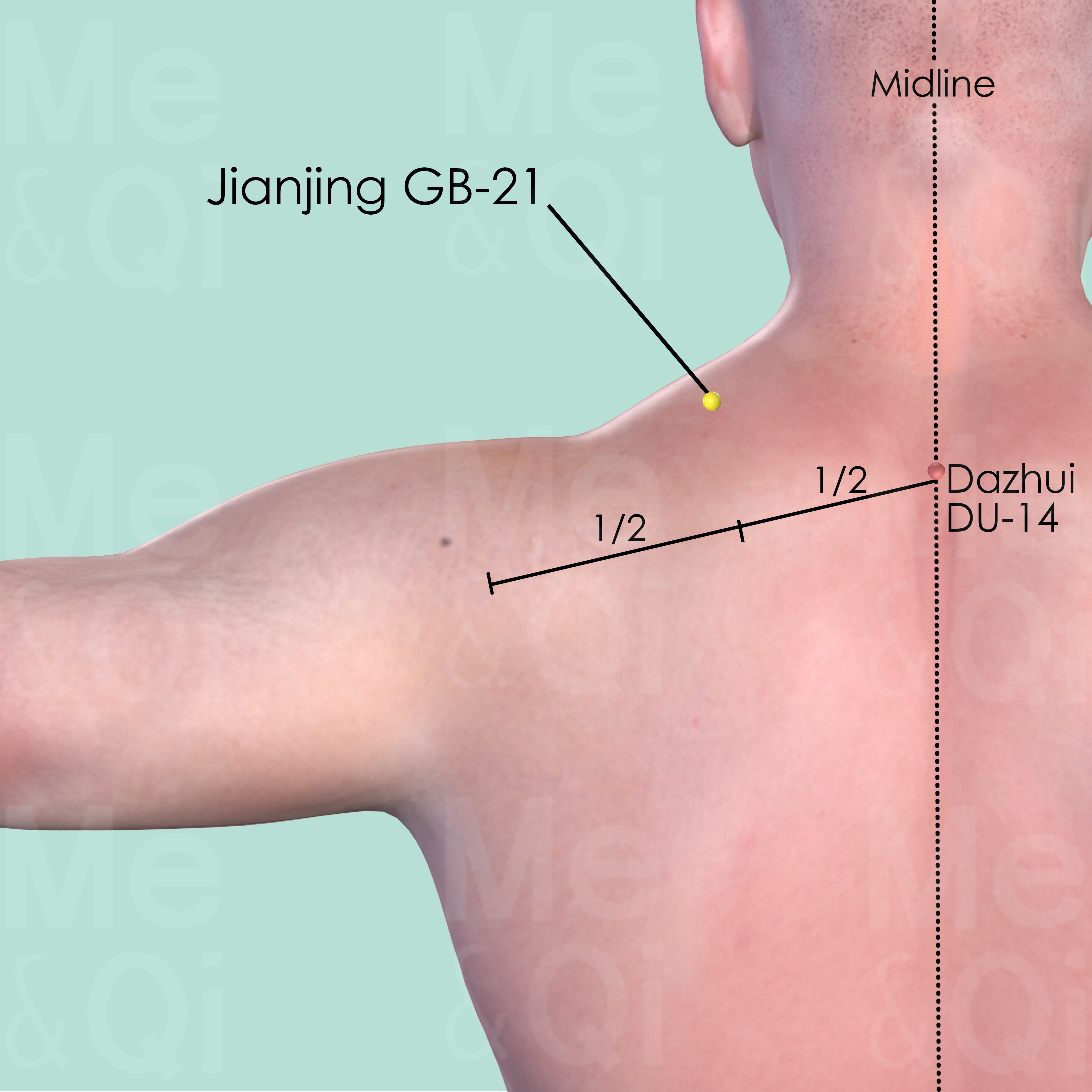
Jianjing GB-21
Midway between Dazhui DU-14 and the lateral extremity of the acromion, at the highest point of the shoulder.
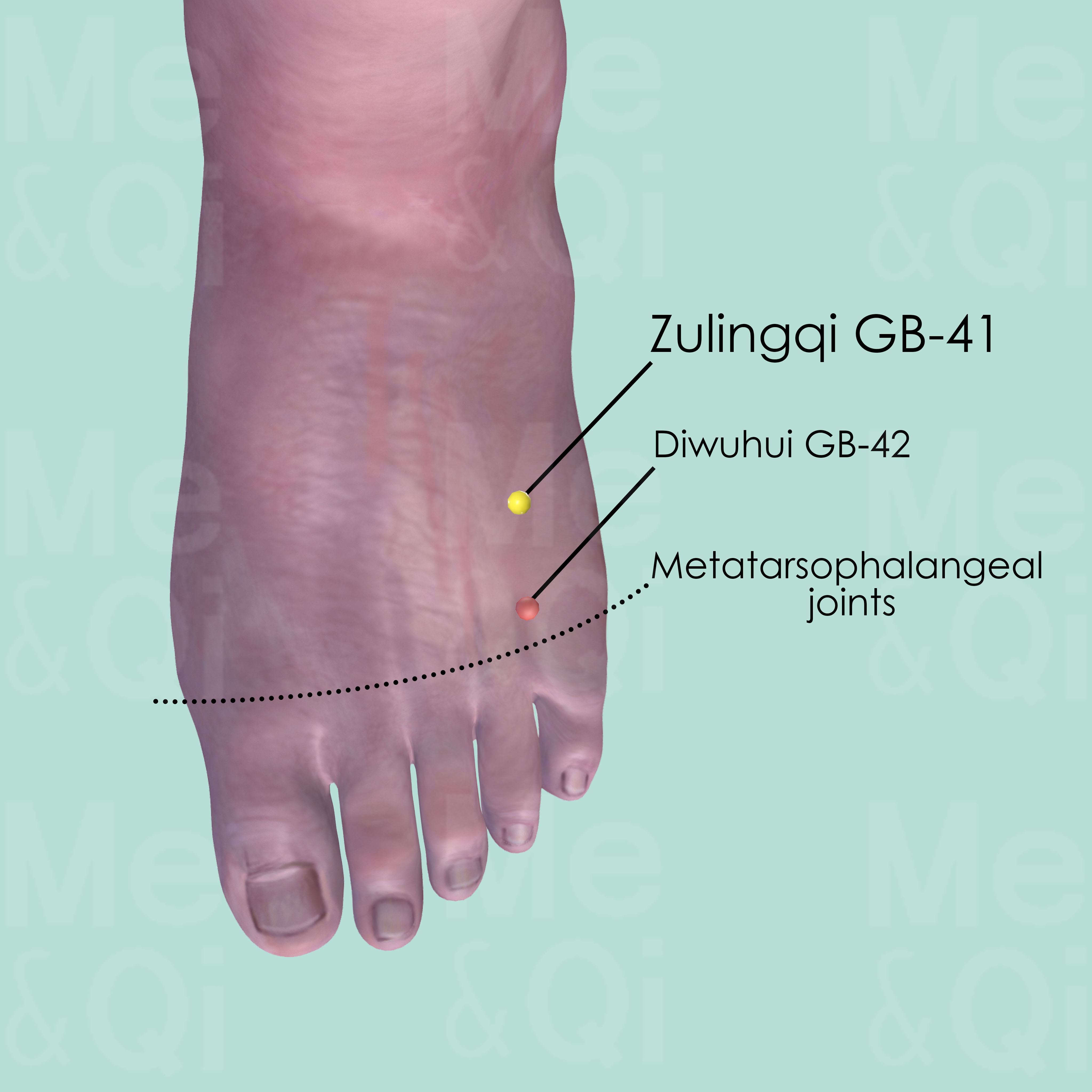
Zulingqi GB-41
In the depression distal to the junction of the 4th and 5th metatarsal bones, on the lateral side of the tendon of extensor digitorum longus muscle of the foot.
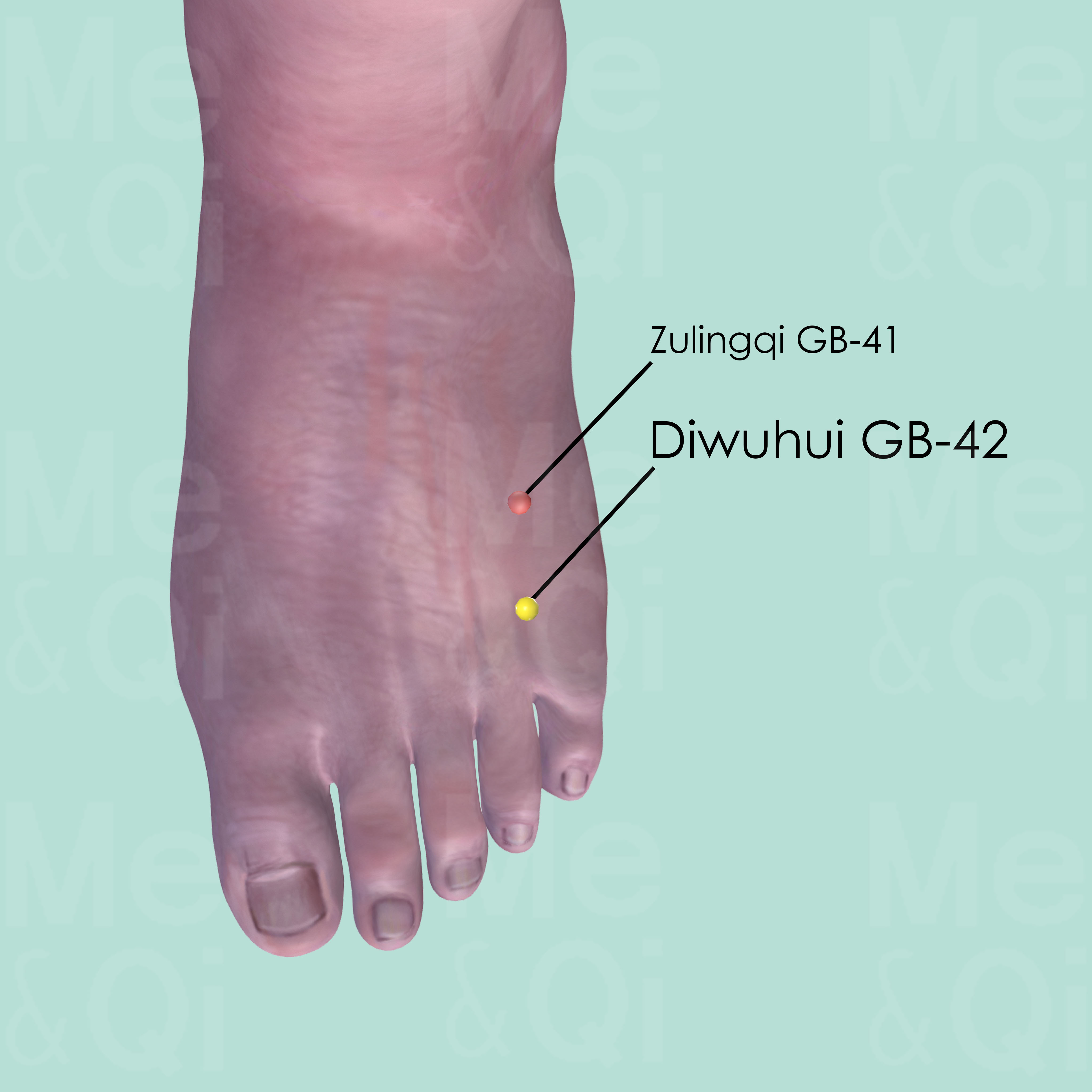
Diwuhui GB-42
Between the 4th and 5th metatarsal bones, on the medial side of the tendon of extensor digitorum longus muscle of the little toe.

Wuyi ST-15
In the 2nd intercostal space, on the mammillary line, 4 cun lateral to the anterior midline.
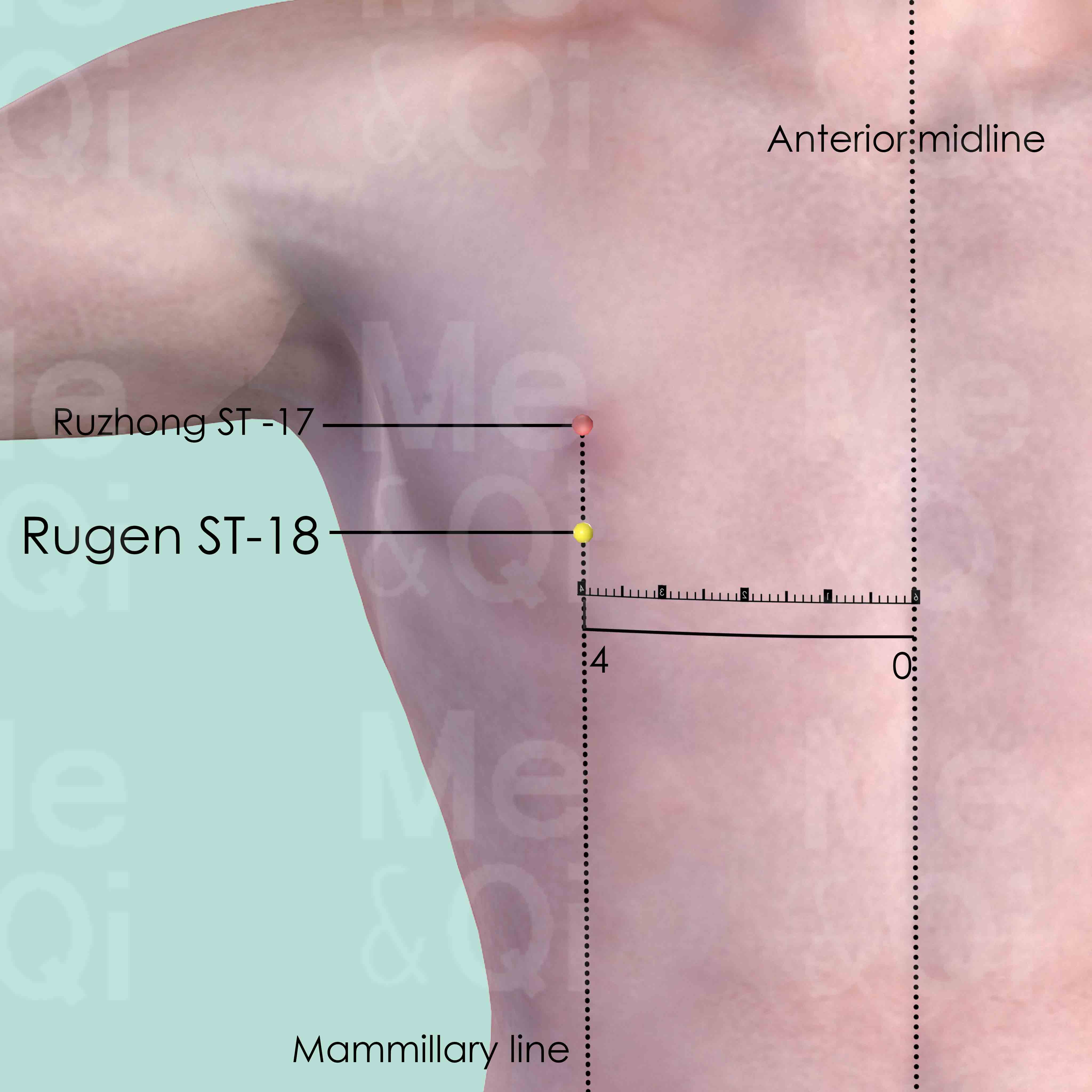
Rugen ST-18
In the 5nd intercostal space, on the mammillary line, 4 cun lateral to the anterior midline.
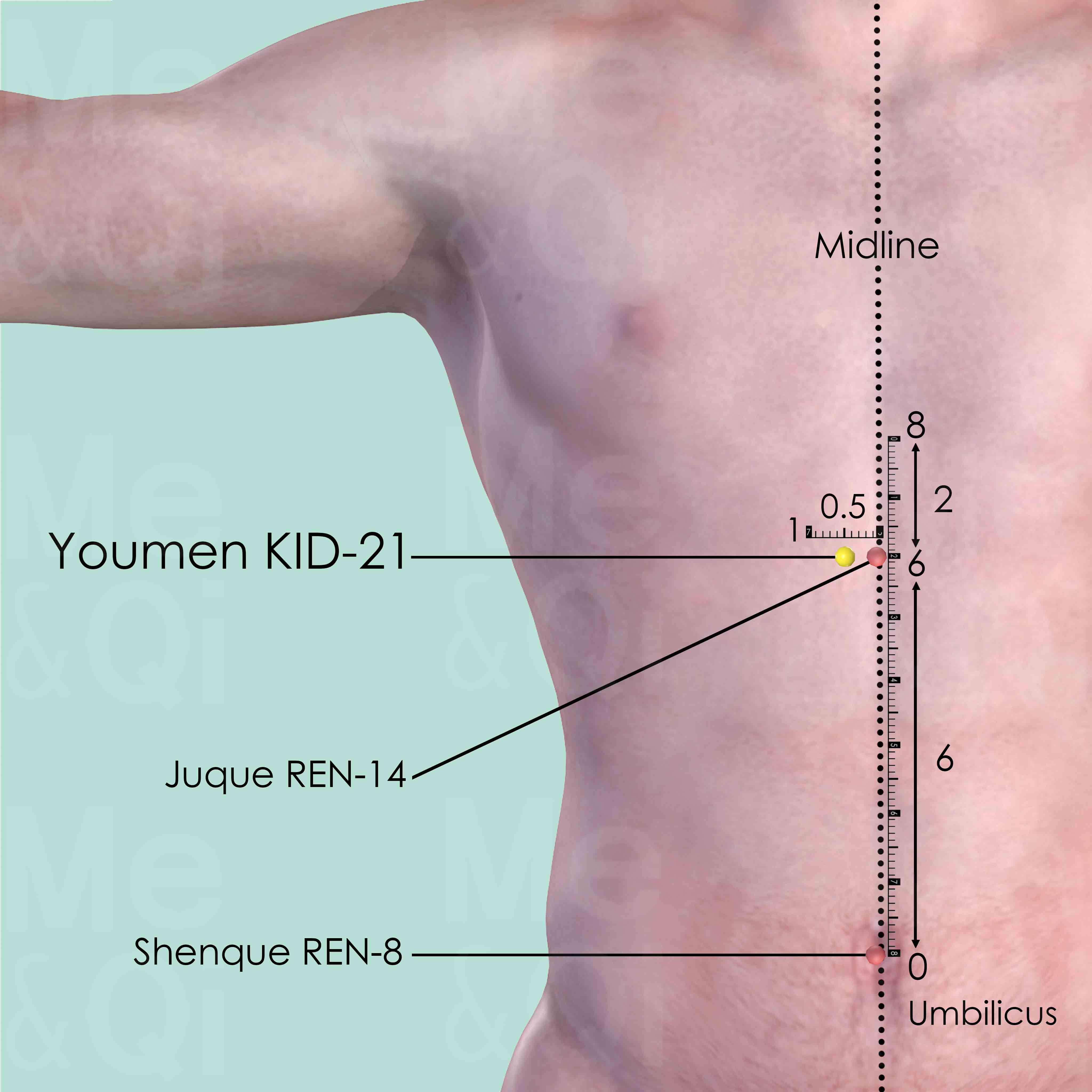
Youmen KID-21
6 cun above the umbilicus and 2 cun below the sternocostal angle, 0.5 cun lateral to the anterior midline.
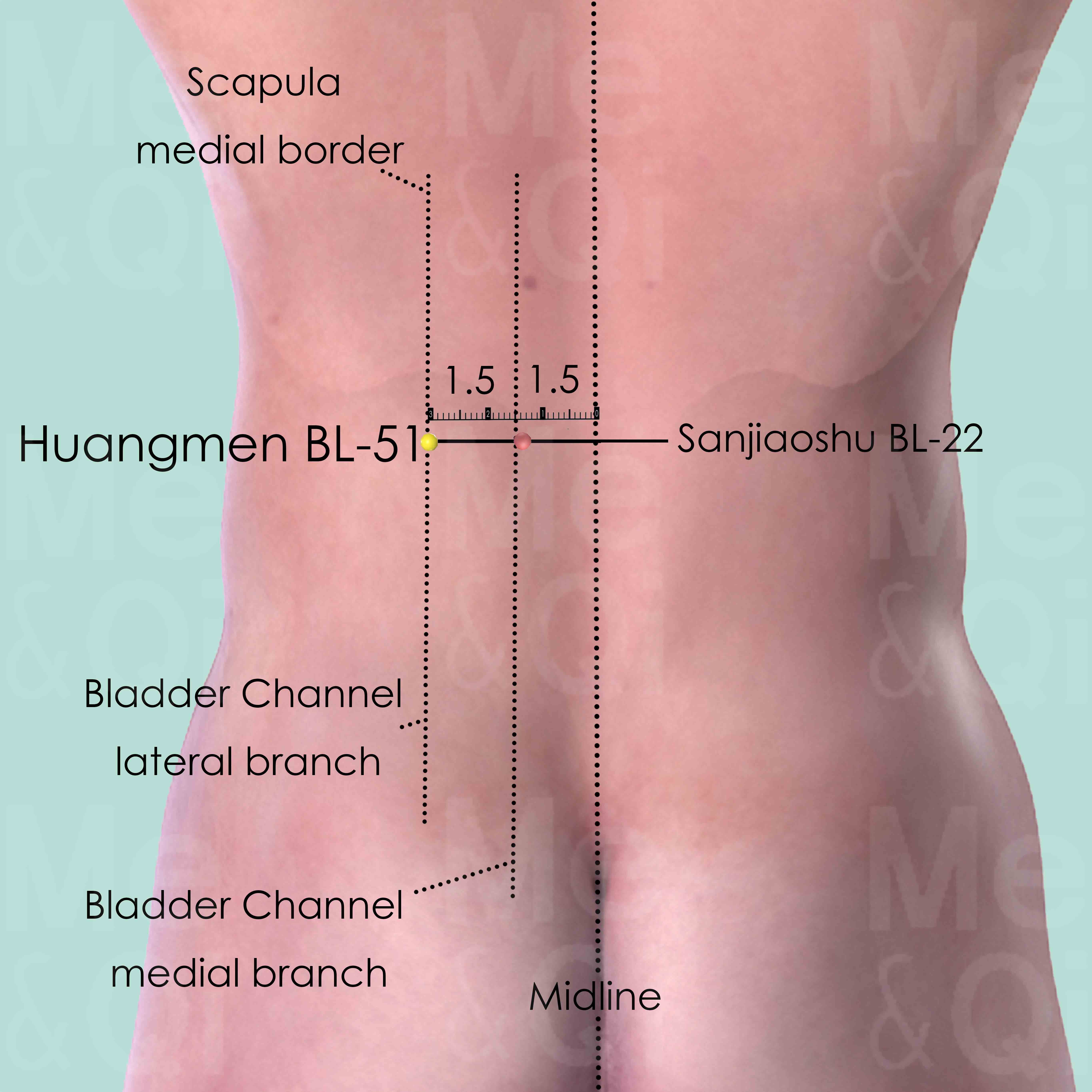
Huangmen BL-51
3 cun lateral to the lower border of the spinous process of the 1st lumbar vertebra (L1).
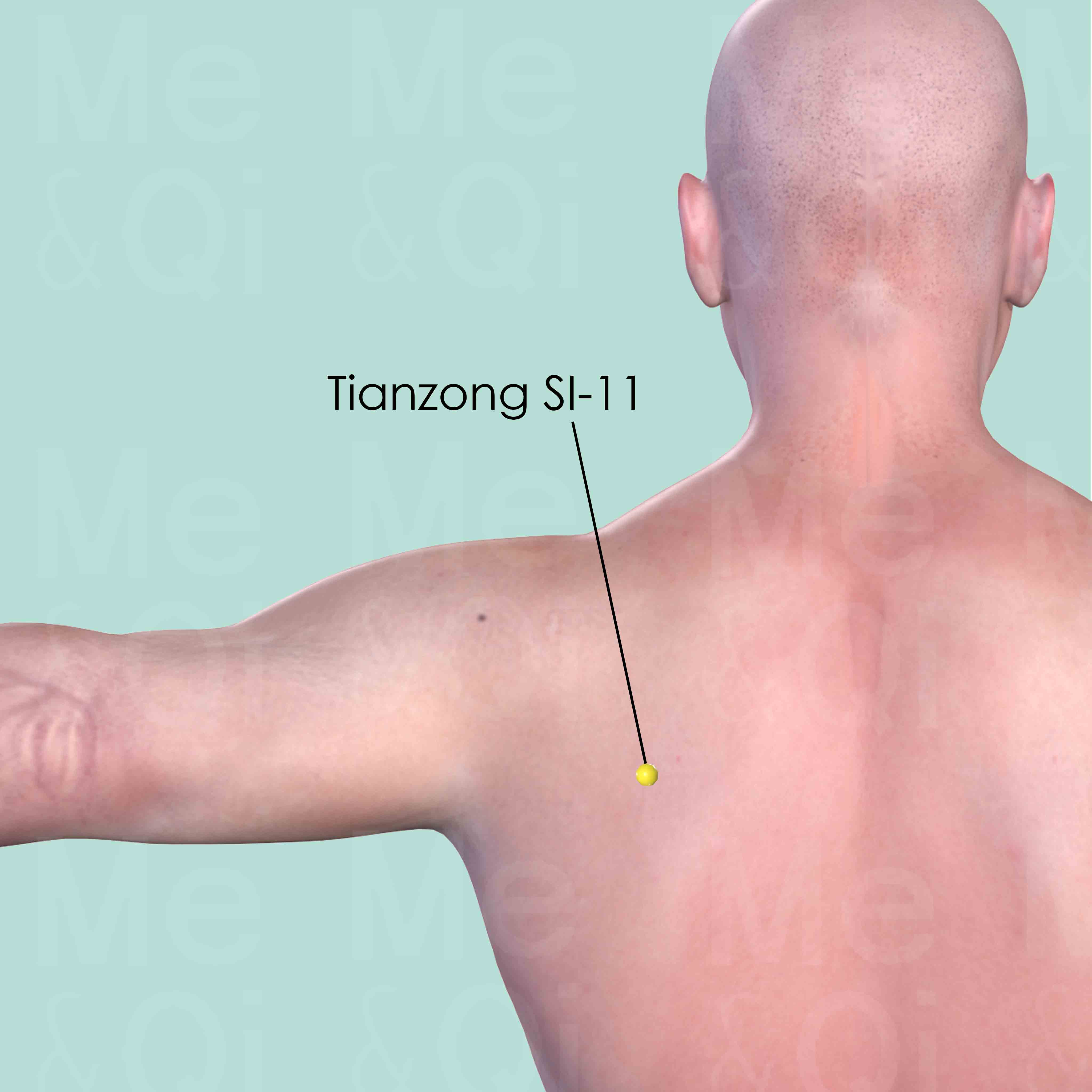
Tianzong SI-11
In the intrascapular fossa, at the junction of the upper and middle third of the distance between the lower border of the scapular spine and the inferior angle of the scapula.
